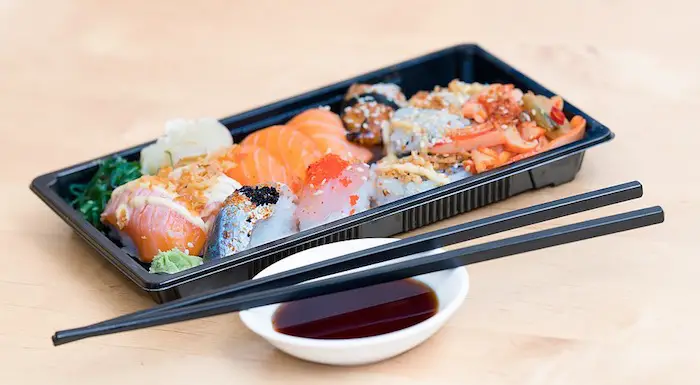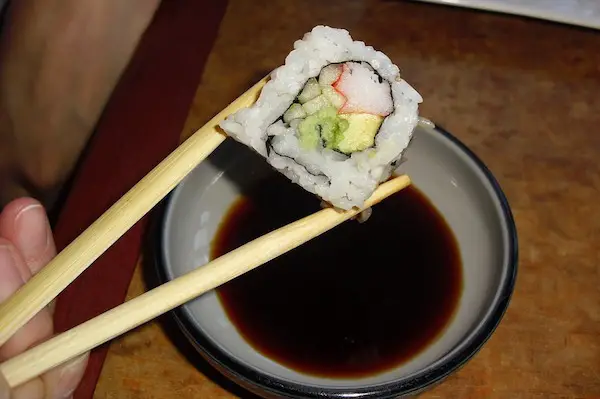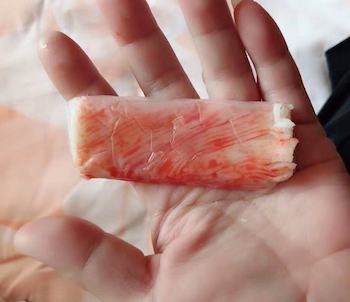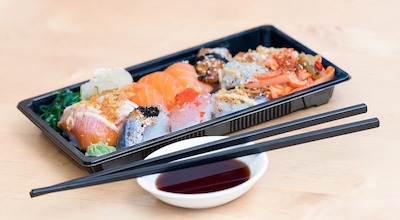We are reader supported. When you purchase through links on our site, we may earn an affiliate commission. Also, as an Amazon affiliate, we earn from qualifying purchases.

Sushi is just rice, fish, and vegetables, so there’s no chance of any gluten in it, right? Heck, no! Your favorite sushi roll may contain hidden gluten coming from soy sauce, vinegared rice, marinade, or tempura – all things you love so much. Many people learn this the hard way after they suffer from unpleasant symptoms, so today, I will tell you how you can eat sushi on a celiac diet.
What sushi is gluten free? If the sushi contains gluten-free soy sauce and grain-derived vinegar with raw fish and fresh vegetables, it can be safely called gluten-free. You must also avoid marinated fish, imitation seafood like surimi, and any form of tempura.
As you can understand, gluten may creep into every part of your favorite sushi roll without your knowledge, unless you are well-informed. While you can still enjoy your favorite Japanese delicacy, you will need to be more careful about the restaurant you choose and the way you order.
After several months of experimenting and in-depth research, I have finally been able to decode the gluten-free sushi for you. So, let me take you through the different aspects of the dish and show you some tricks to keep gluten away from it.
Contents
#1. Soy Sauce

Most people with celiac disease go wrong with this one and soy sauce becomes the biggest culprit in adding gluten to your food intake. So, the most crucial step here is to find a restaurant that serves gluten-free soy sauce.
Ask the server if they have the gluten-free sauce as soon as you take a seat. If they give you a blank expression or reply with a ‘No,’ tell them politely to excuse you and walk away. If a restaurant cannot serve gluten-free soy sauce, there’s a slim chance that they can avoid other factors contributing to gluten in sushi.
#2. Say No to Salmon

Ahh! I know how much you love raw salmon on top of your shari or sushi rice, but believe me, it can be the reason for gluten poisoning. Most of the sushi restaurants use vinegar for curing salmon. While not all types of vinegar are enemies of a celiac diet, most of them are made from wheat, barley or rye.
If a restaurant mentions that they offer gluten-free sushi, they would probably use grain-derived vinegar for preparation. So, make sure to inquire about the type of vinegar used. When in doubt, stay away from salmon. You may substitute the creamy salmon roll with spicy tuna roll instead.
#3. Marinated Fish
Some sushi recipes may contain marinated fish and added flavorings to make them taste out of this world. Freshwater eel or unagi typically fall under this category, but salmon and tuna may also be marinated before using them in sushi.
The reason to avoid marinades is that they are made of teriyaki sauce or soy sauce that may contain wheat, which is a source of gluten. Thus, it’s best to avoid sushi containing marinated fish unless the chef uses gluten-free soy sauce for food preparation. So, ask before you order.
#3. Sticky Sushi Rice
The sushi rice may not get its due respect, but it humbly stays at the background and adds a fantastic flavor to your favorite sushi. However, people with celiac disease will have to be careful about the sticky rice that holds other ingredients together.
Just like marinades, cooked sushi rice is seasoned with vinegar, sugar, and salt before using it in sushi preparation. Always ask what vinegar was used in seasoning the rice before ordering. Restaurants that serve sushi for those with dietary restrictions will oblige and give you non-gluten rice seasoned with rice-derived vinegar.
#4. Sauces In Your Sushi
Most sushi chefs will add just the right amount of soy sauce and wasabi while preparing a nigiri or sushi roll. If the chef uses gluten-free soy sauce or real wasabi, there’s no need to worry. However, most restaurants in the US serve fake wasabi made of horseradish, corn starch, and fillers that may be laden with gluten.
Real wasabi is not only expensive and gluten-free but rare to find. To be on the safe side, you may request your chef not to add any condiments to your sushi roll. I would suggest you carry your own gluten-free soy sauce to avoid any mistakes.
#5. Tempura Or Anything Fried
I know the tempuras taste heavenly, but it’s better to avoid them than get sick later on. Any type of tempura item, whether fish, seafood, or vegetable is dipped in a wheat flour batter and then deep fried. Tempuras are considered to be one of the major sources of gluten found in sushi.
If you are an ardent fan of tempuras, I would suggest that you make gluten-free tempura at home. You can read my article that contains recipes and tips on making gluten-free tempura batter.
However, it is unlikely for a restaurant to serve tempura suitable for a celiac diet, so just stay away from it. Your body will thank you for this.
#6. Fake Fish or Seafood

The fake or imitation seafood is rife in the sushi world and people don’t seem to have any issues with it. As a result, these foods have found a permanent place in Japanese cuisine. For example, imitation crabs or surimi may taste a lot like real crab meat and cost much less. However, these substitutes are made of ingredients that may contain gluten.
Imitation crab sticks are made by grinding white Pollock fish mixed with cornstarch, flavorings and other fillers. Thus, any sushi roll that contains imitation food should be avoided at all cost. If you must eat California roll, order the one that contains real crab meat or avoid it altogether.
#7. Extra Spices And Condiments
Eel Sauce is typically made of rice wine, sugar, and soy sauce, so gluten has a fair chance of creeping into it unless the chef uses gluten-free ingredients. Also, remember that every restaurant may have its own variation and add extra ingredients to enhance the flavor. So, remember to ask the server.
Teriyaki sauce should also be avoided because it is made from wheat sources. Ponzu sauce may also contain soy sauce, so make sure it is gluten-free before consuming. You must also avoid any sushi that contains cream or mayo in it.
Gluten-Free And Safe Ingredients in Sushi
Enough of scaring you with ingredients that can possibly trigger celiac symptoms. I also have some good news to share with you. So, here are a few ingredients that are absolutely safe to include in your sushi.
Lobok is a type of Chinese radish that can be used in recipes that contain Daikon radish. If not cooked in soy sauce or deep fried, you can safely call it gluten-free.
Fish eggs (masago, tobiko) are round, shiny little red or orange colored eggs used for garnishing on top of sushi. Masago is the cheaper version of tobiko, and the later may be dyed in black, green or red color to add more appeal to the dish. Some variations may contain soy-sauce so better avoid the dyed ones.
Gluten-free sushi rice is fine as long as it is not seasoned with wheat or barley based vinegar. It may however also depend on your tolerance level. Some people on a celiac diet feel fine after consuming rice while others do not.
Raw fish that is not marinated or fried is safe to eat. You may also eat King crab, but not the imitation crab sticks. Fresh vegetables and fruits like avocados, cucumbers, mango, and carrots are also safe to eat.
Sushi Rolls You Can Order On A Celiac Diet
As mentioned above, you need to be careful about what sushi is gluten free and make sure gluten does not creep in unnoticed. California roll is the right choice if it contains real crab meat inside. Make sure the chef uses gluten-free soy sauce and rice-derived vinegar for sushi preparation.
Another good gluten-free option is the Rainbow roll, an inside-out sushi containing a selection of raw fish toppings such as tuna, halibut, yellowtail, and salmon. Ask the chef to substitute the imitation crab stick with real crab meat or avocado.
King Crab roll is another safe and delicious gluten-free option. The ingredients include King crab, cucumber, and avocado. Tell your server to skip the mayonnaise and sauce, unless they use gluten-free sauce.
You can experiment with different variations when making sushi at home to enjoy this delectable food without turning it bland or having to deal with the symptoms.
Tips To Help You Find Gluten-Free Sushi
If you wish to dine out at a sushi restaurant, call them beforehand, and find out if they can handle your sushi restrictions. It’s better to be informed than spoil your evening.
Tell the server firmly that you are on a celiac diet or are gluten intolerant. Tell them to not only make gluten-free sushi but also avoid the risk of cross-contamination by using separate utensils, spoons, and knives.
Befriend the master chef in your favorite sushi restaurant so that he knows about your diet. He will know what is safe for you and prepare your order separately without having to be told every time.
If the restaurant does not serve gluten-free soy sauce like this, tell them to skip the sauce part entirely. Carry your bottle of gluten-free sauce to stay safe.
If you are still afraid of cross-contamination, avoid dining out, and make your own sushi at home. You can find gluten-free options at an Asian grocery store or buy them online.
Related Questions
Why should you not order a Sushi Boat style?
This is a style of sushi that has different types of sushi stacked together, and customers can take what they like. When you are on a celiac diet, this can carry the risk of cross contamination. Make sure your sushi is always made to order, especially for you.
What is tamari?
Tamari is gluten-free sauce you can find at any Asian grocery store or online. They also come in small packets so that you can carry them with you and use with your sushi if the restaurant does not serve gluten-free sauce.
Can a bamboo mat cause cross contamination
Yes, of course, because the sushi chef uses a bamboo mat for rolling different types of sushi that may contain fried ingredients. You may not want gluten to get into your roll so politely request your chef to use a different bamboo mat, gloves, and chopping board, and knife.

